Lessons Learned Bulletin No. 11
June 2017
JRC 107242
pdf version (en) ER2 – Leerpunten van incidentbestrijding –Voorbereiding en bescherming van de brandweer (nl)
Return to Lessons Learned Home Page
Chemical Accident Prevention & Preparedness
Learning from emergency response – firefighter preparedness and protection
The aim of the bulletin is to provide insights on lessons learned from accident reported in the European Major Accident Reporting System (eMARS) and other accident sources for both industry operators and government regulators. In future the CAPP Lessons Learned Bulletin will be produced on a semi-annual basis. Each issue of the Bulletin will focus on a particular theme.
Emergency response
The current issue is the second part of a series of lessons learned from research on emergency response. In particular, it discusses lessons learned from emergency response about firefighter preparedness and protection. The first part in the series addressed lessons from evacuation, sheltering, containment and accidents involving spectators. Meanwhile the third and last part will describe important lessons learned for emergency response,in general, that is, excluding themes covered already in parts one and two.
Please note:
The accident descriptions and lessons learned are reconstructed from accident reports submitted to the EU’s Major Accident Reporting System
https://emars.jrc.ec.europa.eu
as well as other open sources. EMARS consists of over 1000 reports of chemical accidents contributed by EU Member States and OECD Countries.
The cases selected for this bulletin also generated a number of lessons learned, not all of which are detailed in this bulletin. The bulletin highlights those lessons learned that the authors consider of most interest for this topic, with the limitation that full details of the accident are often not available and the lessons learned are based on what can be deduced from the description provided. The authors thank the country representatives who provided advice to improve the descriptions of the cases selected.
|
Accident 1
Source of leak unknown
Sequences of the event
A fire started at the manhole of an inspection pit for underground pipes of a petroleum storage depot during a welding operation as part of maintenance work on the piping supplying a tank. The underground pipes were feeding eleven tanks in different conditions. At 11:15 a.m., a leak of premium-grade gasoline occurred, followed by a sudden flash. Site technicians attempted to extinguish the ensuing pool fire. The operator activated the internal emergency plan, issued the order to close all motorised valves and called for assistance from petroleum industry partners. At 14.00, emergency responders were still unsuccessful in suffocating the fire with sand. At 15:20 an explosion occurred which was caused by two acetylene cylinders used in the welding operation. Fed by an unknown source, the fire continued to rage for several hours despite firefighting interventions. Eventually, the foot valve on the adjacent gasoline tank was found open by the firefighters. After its closure, the fire receded Intervention efforts were substantial and the toll quite heavy; 15 firemen were burned during the accident: 2 of them were badly hurt, 5 seriously and 8 slightly. Apparently, the firemen suffered burn injuries due to a gust of wind and for the cylinders' explosion. The entry valve of the adjacent tank was left open for an unknown reason.
|
Important findings
• According to the site director, the piping should have been submerged in water during the onsite works and therefore was omitted from the valve closure checklist and control diagram.
Firefighters encountered myriad difficulties, in particular:
• The fire route to the tank was submerged under a layer of burning hydrocarbons;
• Fire water pipes burst under the weight of vehicles evacuating the zone;
• Lack of information about the source of the fire.
Lessons Learned
• The accident scenario was not included in the site’s risk assessment study. Fires initiated from welding operations are abundant in the literature. A hazard assessment of tank maintenance operations should examine all possible ignition scenarios (what if?) associated with hot work.
• In order to prevent subsequent fires or explosions to occur, ignition sources, such as the acetylene cylinders should be removed from the area of emergency operation.
• Operators should provide accurate information on location of safety instrumentation to the emergency responders as soon as possible, especially if such devices can contribute to the fire or explosion.
[EMARS Accident #292 and ARIA #3396]
|
Emergency response - Firefighters involved
The analysis followed the period between 1990 and 2015. In the last 25 years,56 of the 753 accidents (5%) were reported as having resulted in the death or injury of one or more emergency response team members. Figure 1 shows all cases that resulted in a firefighter casualty or death. Overall, 13 emergency response team members died in responding to a chemical accident and quite a significant number suffered injuries. Figure 2 shows the fatalities and injuries per accident. Out of 28 cases with slight injuries, 11 accidents involved firemen who suffered broken bones or hearing injuries. Meanwhile in 17 cases mainly respiratory or burn injuries as a result of intoxication or inhaling smoke happened.The current bulletin focuses on the aspects of emergency response rather than the chemical process and the direct causes of the selected events. The main objective is to learn why and how firefighters or company emergency responders died or were injured in the accidents in order to follow better practices in the future.
Figure 1: Number of accidents with firefighter effects (Source: eMARS)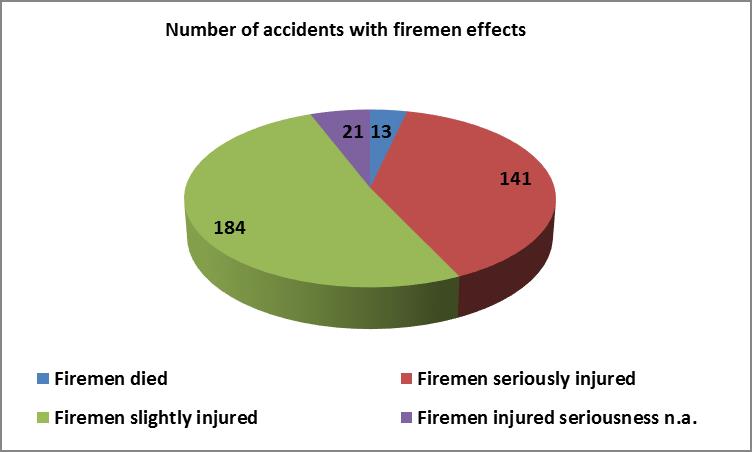
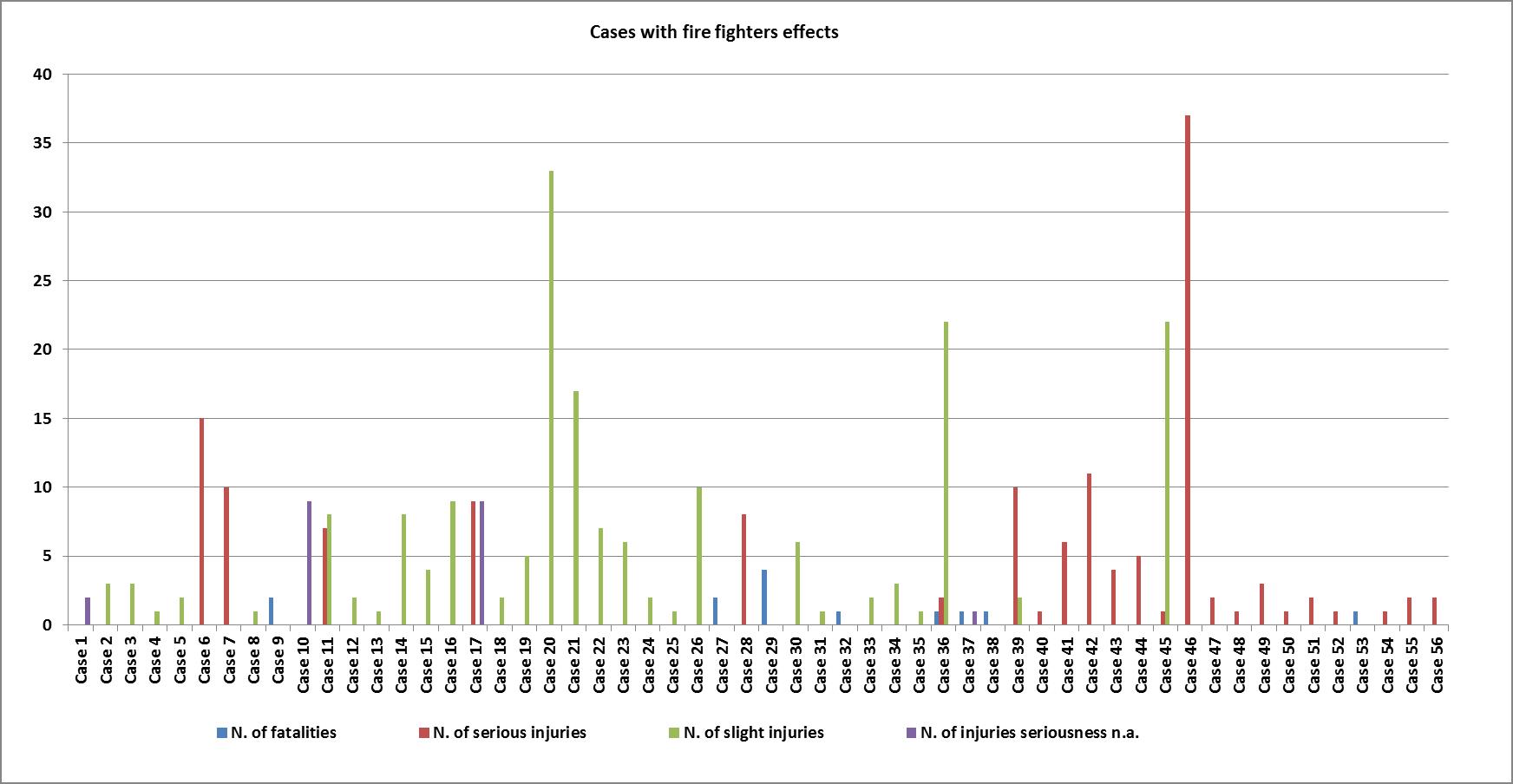
Figure 2: Cases with firefighter deaths or injuries (Source: eMARS)
In these cases, the firefighter impacts were often associated with one or more of the following contributing factors:
- A sudden, unexpected explosion occurred while firefighters were battling the fire.
- Firefighters lacked knowledge about the characteristics of hazardous substances involved in the accident.
- Firefighters lacked adequate personal protective equipment. In one case, a firefighter suffered pulmonary blast from the explosion. He did not wear a self-breathing apparatus since he had not been directly involved in the fire-fighting effort. Other members in contact with the blaze were wearing such apparatus and did not have to be treated for similar lesions, even though some were actually closer to the explosion epicentre. It appears, that this respiratory device was able to protect against blast effects.
- After an explosion, some firefighters suffered serious injuries that were not directly caused by the blast effect, but instead were generated by indirect shockwave effects (collapse of structural elements, projectiles, etc).
- There was an inadequate supply public water available due to blocked access to the fire hydrants. In other cases, the site lacked sufficient fire water, orthe public supply network lacked sufficient pressure to send the water all the way through the hose to the point of delivery, which delayed the intervention.
- The presence of large quantities of combustibles made the emergency response operations even more difficult.
- Emergency responders were not able to keep in good communication with each other throughout the response effort due to lack of mobile phone network coverage.
Accident 2
The Tianjin accident
Sequence of events
On 12 August 2015 at 22:51:46, a fire broke out in the delivery zone of an international logistics company hazardous goods warehouse in China, Tianjin. After being alerted, firefighters from the Port Fire Brigade arrived at the scene within four minutes. They saw a big fire on a pile of containers which blocked the passage ways to the delivery zone. The commander of the team asked the employees of the warehouse about the substances present but they did not know what substances were stored. As a general approach, firefighters started to fight the fire with water which, turned to accelerate the magnitudeof the flames. Since the fire intensified rapidly, the commander ordered firefighters to evacuate the delivery zone, and to continue to control the spread of the fire still by spraying water to the containers and asked for backup. The first explosion occurred at 23:34:06, followed by a second, more violent blast 31 seconds later. There were 6 major fires and dozens of small fires at the scene. A total of 165 lives were lost in the accident, including 24 firefighters from the public security personnel on duty, 75 from Tianjin Harbour Fire Brigade, 11 police officers and 55 civilians. Eight people went missing, including 5 firefighters from Tianjin Port Fire Brigade and 3 family members of firefighters from the Brigade. A total of 798 people were injured. Overall 304 buildings were damaged, among which 73 office buildings, factories and warehouses. Apparently, rough handling during the moving, loading and unloading of nitrocellulose directly resulted in the spontaneous combustion. The flame of nitrocellulose spread and ignited the containers with ammonium nitrate (~800t) stored in the port without permission. In addition, over 100 types of substances, many of which were flammable, were stored in the warehouse at the time of the accident.
Important findings
• The site did not have an emergency plan as required by regulation. Therefore, site emergency preparedness was limited so as to be almost non-existent. Firefighters did not know the facility since on-site training and joint drills had never been organised.
• Firefighters had difficulties to extinguish the fire, because the fire engine access was blocked by containers and the nature of the materials that involved in the accidentwere unknown. These factors delayed the emergency response significantly.
• The first responders that were dispatched to address the fire made things worse by fighting the flames with water, because the chemicals present in the warehouse were combustible when in contact with water, leading to an explosion. The Port Fire Brigade had contracted firefighters with lack of overall knowledge about hazardous substances. Moreover, there had never been any discussion with responders about chemicals stored on the site. Therefore, they did not know the safe way to intervene or what to expect to happen.
• The sheer number of hazardous chemicals (over 100), both in terms of variety and quantity, involved in the accident contributed to difficulties in rescue operations. In addition, the large amount of sodium cyanide, ammonium nitrate and various flammableand explosive chemicals scattered around the scene of the accident added to the many uncertain risk factors.
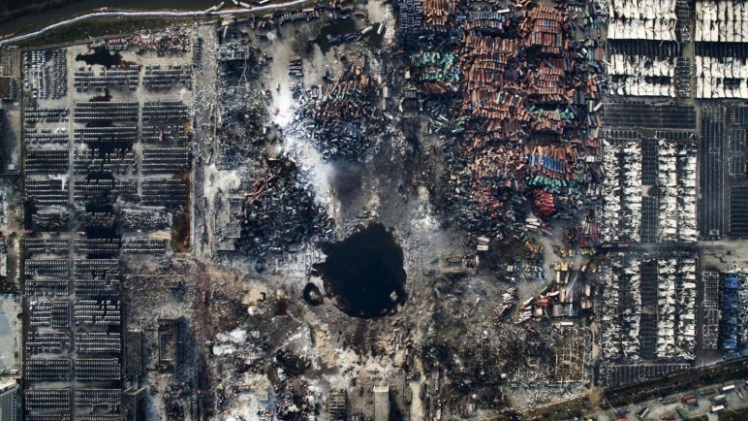 |
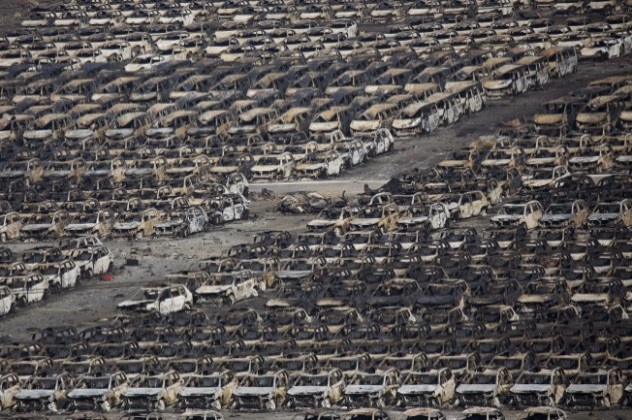 |
|
Figure 3: After the explosions (Source: World Photo Press/Chen Jie)
|
Figure 4: Cars for sale (Source: Reuters/Damir Sagolj)
|
Lessons learned
• Operators of dangerous sites should be aware of any potential worst-case scenarios and inform first responders about the associated hazards which would enable them to be prepared to the intervention and prevent injuries. As such, companies should ensure they are able to advise emergency services/external authorities of the potential toxicity of products of combustion from mixed chemical fires.
• Firefighters did not have adequate information about the characteristics of the burning chemicals. In such cases, it is common practice that first responders initially equip themselves with the highest level of protection, then gradually back down to lower levels as major hazards are eliminated or determined to be non-existent. This precautionary approach limit spotential exposure of firefighters to the most severe hazards. Furthermore, the incident commander must conduct an ongoing evaluation of the situation, using the best knowledge available, in order to take the safest approach to tactical operations and develop appropriate response plans before taking decisions with risks for firefighters.
• Operators should preparethe emergency plan based on a comprehensive risk assessment. They should review and revise the on-site emergency arrangements periodically and as necessary to ensure that plans remain current with evolving operations and that relevant staff are trained and remain competent to execute the plans. They should ensure that there are enough trained staff available at all times to perform all the actions required by the on-site emergency plan. Municipal, volunteer and industrial fire brigades should be involved in the emergency response arrangements, trainings and drills. They have to gain knowledge about the facility and the emergency procedures to intervene effectively and prevent injuries to their teams.
[Tianjin investigation report in Chinese at http://www.taihainet.com/news/txnews/cnnews/sh/2016-02-05/1666242.html and http://onlinelibrary.wiley.com/doi/10.1002/prs.11837/epdf. Also at https://www.firerescue1.com and Structural Firefighting by Bernard J.]
Accident 3
West Fertiliser Company
Sequence of events
In 17 April of 2013, a fire broke out at the West Fertilizer Company in West, Texas, USA. After their arrival, firefighters started to fight the fire, when a detonation occurred. As a consequence of the explosion, the shock wave crushed buildings, flattened walls, and shattered windows. Twelve firefighters were killed along with three members of the public who were volunteers and helped to fight the fire. At least 250 people were injured and more than 150 buildings were damaged or destroyed in the accident.
Important findings
• The volunteer firefighters who responded to the fire did not have sufficient information to make an informed decision on how best to respond to the fire at the fertilizer facility.
• There was confusionon the response teamabout the characteristics of the fertilizer. It was thought that it would not explode and that it was far away from the blaze so as to not concern the firefighters. As a result, the strategy and tactics utilized by the volunteer fire brigade were not appropriate for the quickly escalating situation. This confusion also contributed to the fact that no evacuation was ordered in time.
• The investigation found that firefighters did not receive specific training on firefighting strategy, tactics and emergency response to storage sites that handle fertilizer grade ammonium nitrate.
• There was no incident command system. The emergency scene operation was conducted in an unstructured manner without adequate supervision.
Lessons learned
• The investigation revealed that the responding fire brigade had no standard operating procedures. Specific standard operating procedures and trainingregarding firefighting and emergency scene tacticsfor respondingto high hazard facilities are essential.
• Volunteer firefighters should be provided with standardised training to be able to prepare for intervention in case of presence of dangerous chemicals. Simulation exercises should be conducted to provide experience in managing complex and unfamiliar situations.
• Fire departments should visit hazardous chemical sites under their jurisdiction and prepare a pre-incident plan of the facility. This will better prepare them for the hazards which may be found in the event of a fire and provide them with insight to when it is necessary to attack a fire or evacuate the area.
• Emergency responders should have a good two-way communication of hazards and risks between the site operator and the site emergency services.
• A command post should be established at the beginning of the accident for optimal organization and supervision of the ongoing operation and pull back firefighters if the situation escalates. Prior to deciding upon the tactics, incident commander should perform a risk assessment before committing crews into a risk area. A good command and control structure for managing the incident is critical.
[http://www.csb.gov/west-fertilizer-explosion-and-fire; “Bad seeds” at www.fireworld.com2014/Vol29/No.3]
|
Accident 4
Warehouse false alarm
Sequence of events
In one of the buildings of a warehouse facility, a fire alarm triggered the activation of the automatic foam extinguishing system on 30 April 2012 at 18:56. The surveillance firm immediately called two leaders, the head of warehouse loading crew and the Sales Manager. The head of the loading crew arrived first at the scene and after observing that Cell 1 of the facility was filled with foam, closed the air inlet at the shut-off valve of the foam sprinkler system and called the local fire brigade. When the firefighters arrived, the warehouse unit had already been filled with foam up to the 10-metre-high ceiling. A team of three firefighters, due to the presence of foam and possible fire, equipped withself-contained breathing apparatus (SCBA), entered in the adjacent area to check that the anti-fire doors were properly closed. The fire doors were intact, however, the foam filled also the access corridor, probably escaping from the cell through wall seams. As the team advanced, the foam obstructed vision as well as acted as a sound insulator, preventing verbal exchanges (except for radio). In the end, physical and radio contact with one of the firefighters, who was an experienced fire officer, was lost. When the victim was found, she was in a coma, without her SCBA equipment and with her buddy rope unattached. She died in the hospital three days later. The accident was caused by the technical malfunction of the automatic extinction system. There was no fire in the warehouse.
Important findings
Several underlying causes contributed to the death of the fire officer, in particular:
• The inspection of the unit in question did not show any trace of an initial fire and the most probable hypothesis was that the fire detection system was triggered in an untimely fashion by a short-circuit. It was also revealed, that the cable connecting a manual trigger with the site’s programmable safety controller was subject to wear.
• The three firefighters decided to conclude a physical inspection on the situation due to confusing information regarding the hazardous substances stored. Apparently, there was a misunderstanding in relation to the ICPE category classification versus the UN classification. The responders had received the inventory of the warehouse indicating the classification numbers of the substances stored. The firefighters mistakenly thought that these numbers followed the UN ADR classification system, and the substance was identified as tetranitromethane, a toxic combustible product which accelerates fire. In reality, however, the number corresponded with the French ICPE classification system, a designation for environmentally sensitive installations. As a result, the firefighters agreed on performing a reconnaissance to check on smouldering flames.
• Forensic analysis showed that the foam had an unusually compact and sticky consistency (compared to cream cheese), which forced the three SCBA-equipped firefighters attending the scene to overconsume air and meant that their masks were no longer airtight and slipped on their faces.
|
|
• Given the foam’s density, the victim had no visual contact and was unable to communicate with her two colleagues. She had lost contact with her immediate partner due to the fact that the personal connecting cord had been attached to the carabiner on the partner’s backpack, but the connection should have been via the belt. When her fellow responders decided to turn back, owing to a lack of air in their self-breathing devices, unaware of their decision, they removed their backpacks leaving the victim alone, disoriented, and short of air.
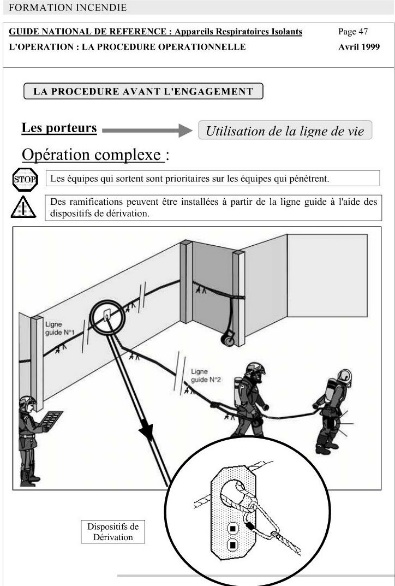
Figure 5: Guideline for fire-fighters (Source: http://en.calameo.com)
Lessons learned
• Information about the labelling of hazardous materials should be clear and the operator of the establishment should provide the correct information to the emergency services in order to avoid confusion.
• As the internal emergency plan response sheet stipulated, the surveillance firm was supposed to call the national fire emergency number “18”. The entry log, however, indicated that contact number to fire-fighters unknown. Entrylogs should be updated with the correct contact details o femergency services.
• Emergency responders should follow the protocol in case of emergency response, and therefore be prepared to choose the adequate level of personal protection equipment. It also means choosing larger air cylinders that allows alonger interval ofintervention.
• Team members should always maintain continuous awareness of their SCBA air supply and ensure that no firefighter is left alone at any time while entering, operating in or exiting a building. They are also required to abandon their position and retreat before being harmed by deteriorating conditions.
• When entering in a building with limited visual contact, such as, whenthe area is engulfed in smoke or filled with foam, to perform reconnaissance, hoses and ropes should be used as aiding tools that help in case of early exit to a safe area.
[EMARS Accident #958 and ARIA No. 42122]
|
Accident 5
Processing of metals
Sequence of events
On July 14, maintenance works were completed in a soy beans extraction plant. Following the inspection by the plant operator, the start-up of the facility was initiated at 21:30. Steam was admitted to the toaster and to the jackets of hexane inlet pipes to heat-up the toasters and the extractor to the proper operating temperatures.
At about 21:45 the toasters reached their operating temperature and admittance of flakes commenced through the inlet screw conveyor. After that the night shift took over. They had some difficulties controlling the process temperature (dropped), and therefore increased heat supply to the toaster. About the same time, the sound of the safety flap valve lifting was heard, and it released hexane and steam into the extractor building, where the smell of hexane was detected by the operators. The hexane concentration in the extraction building finally reached a level which forced the staff out of the extractor building. A bus driver passing the plant detected the vapours and informed the Traffic Control Centre that “airplane fuel was spilled on the road”. With this information, at their arrival, firefighters took a precautionary approach and parked the fire engine at a safe distance, walking the last hundreds of meters. The plant manager arrived at the scene and discussed with the incident commander how to stop the outflow of hexane vapour, and deciding ultimately to cutoff the power supply to the extraction plant. The manager there after asked the power control unit to turn off two transformers under the load. (There was also one unloaded). Due to inherent risk of possible sparks he rejected stopping the electrically loaded transformers and instead, disconnected the third, unloaded transformer. Approximately 30 seconds later, a sudden fire was observed outside the plant which was followed by a violent explosion. The explosion injured 27 persons, among 7 emergency responders and 20 staff members of the plant. The extraction plant was destroyed by the explosion and was notre-established. The explosion was probably initiated by the attempt to disconnect one of the three supply lines to the extraction plant.
Important findings
• Apparently, the smell of hexane which was detected by the operators was not an abnormal occurrence during the start-up.
• The site also stored large amounts of chlorine and hydrogen in the facility. Therefore, it was urgent that the incident commander and the plant manager work quickly together to prevent the explosion.
• The investigation revealed that no emergency shut-down procedure existed for the extraction plant.
Lessons learned
• Due to the conflict of following orders, the question arises who is in charge to give orders relating to operation of the plant, is it the incident commander or the operator? Who makes final decisions to shut down the electricity? Roles should be identified during normal operation when the operator drafts the internal emergency plan. The fire brigade should have visits to the plant to become familiar with the operation and discuss the emergency procedures with the plant manager and the control room operators.
• Emergency shut-down operations are crucial when operating a plant with the hazards of release of toxic materials or fire/explosionand that these protocols are followed.
• No alarm was activated to inform the public about the hexane release. Information to the public and activating the alarm is one of the most important emergency protocol in case the consequences might affect the nearby population.
[EMARS Accident #229 and EC Study at https://bookshop.europa.eu/en/ec-study-pbCLNA15562/]
|
Motto of the semester
______________________
“There are some things you learn best in calm,
and some in storm.”
― Willa Cather
MAHBulletin
ContACt
For more information related to this bulletin on lessons learned from major industrial accidents, please contact
zsuzsanna.gyenes@jrc.ec.europa.eu or
jrc-emars@ec.europa.eu
Technology Innovation in Security Unit
European Commission
Joint Research Centre
Directorate E - Space, Security
and Migration
Via E. Fermi, 2749
21027 Ispra (VA) Italy
https://minerva.jrc.ec.europa.eu
If your organisation is not already receiving the MAHBulletin, please contact
jrc-emars@ec.europa.eu . Please include your name and email address of your organisation’s focal point for the bulletin.
All MAHB publications can be found at Minerva Portal.

|
Checklist on emergency response relating
to firefighters involved
• Do emergency responders have a site map that illustrates the location of fire protection equipment, emergency exits and assembly points?
• What means ofcommunication are available on-site for effective coordination between the on-site and off-site emergency teams? Have they been tested in joint exercises to evaluate their effectiveness and identify improvements?
• Are communications maintained constantly with all personnel operating on the scene as well as with plant operations personnel? Are radios intrinsically safe for use in certain industrial circumstances (ATEX)?
• Are there efficient means of information handling during the emergency and good critical communication arrangements available?
• Are there arrangements for families to access to official information about the firefighters involved in the emergency response operation or already been retained from the scene?
• Are there arrangements in place for providing the public and the neighbouring establishments relating to the accident and the behaviour which should be adopted?
• Has the incident command system considered the possibility of overcrowding on channels, different frequencies used, mobile telephone network overload problems?
• Are emergency procedures prepared, agreed and tested before an accident to enable the appropriate emergency response actions to be resourced and available?
• In case of a large scale accident, has a command post been set up to coordinate the operations and ensure the effective communication between the different emergency services operating in the area?
• Does the incident commander have adequate information from the operator to be able to size-up the tactical area of operation and evaluate potential risk exposure and determine a safe approach before firefighters are placed in high risk position?
• Have planned and rehearsed interfaces between the various responders with all aspects of the emergency response been practiced, at all levels (plant, site and off-site), covering all expected scenarios, using both table-top exercises and drills?
• While staging the resources (firefighters, fire trucks and equipment), has the incident commander ensured that adequate information is available about the weather conditions and the wind direction?
• Are (initial) danger zones considered to protect firefighters from exposure of the fire or potential explosion before operation and is it adjusted based on the circumstances? Staging should be out of the danger zone. If the substance is unknown, initial danger zones are recommended, for example 50m for solids, 100m for liquids and 300m for gases.
• Does the incident commander assess fire conditions and risk to firefighters during the intervention and adjust and revise the response plan/tactics to maintain safe operation?
• Before the emergency response have firefighters tested that sufficient fire waterand pressure to send the water all the way through the hose to the point of deliveryis available on site to put out the fire?
• Is adequate personal protective equipment used and even worst case scenarios are considered in determining the level of protection necessary, based on the outcome of the evaluation of the situation?
• Who is in charge for making decisions in the plant? How far the incident commander can go in making decision relating to the operation? Is the operator obliged to accept an external order?
• Are foam couplings or the provision of adaptors between the industrial and municipal fire brigades standardised?
|

